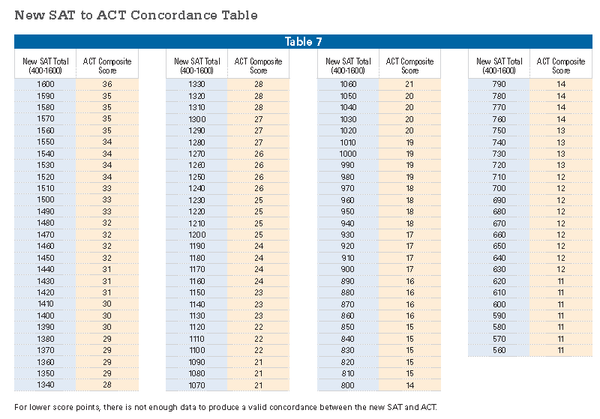How to Compare SAT® and ACT® Scores
October 11, 2017, 12:17 PM
How to Compare SAT® and ACT® Scores
The first thing students notice is that the scoring on the SAT® and ACT® is completely different! For example, the SAT® (since 2016) has scores ranging from 400-1600 whereas the ACT® has score ranges from 1-36. Students obviously want to submit their best scores, so it makes sense to learn how to make this comparison.
The process can be a little technical, so hang in there. We tried to simplify the steps to make it as easy as possible to compare SAT® and ACT® scores. Remember: Knowing how to compare SAT® and ACT® scores can be really helpful for developing your testing plan and submitting scores to college.
Step One: Pull out all “official” test results: These could be official SAT® scores and ACT® scores, SAT® PSAT/NMSQT® scores, and diagnostic SAT® and ACT® scores (if from a reputable source—see below). Since the SAT® was redesigned in March 2016 (and the SAT® PSAT/NMSQT® in October 2015), any scores taken earlier may need a separate comparison table (covered later in the article). This should not be an issue, however, for the Class of 2018 and later.
Note: If you are trying to decide which test to take, here are links to “official” SAT®, SAT® PSAT/NMSQT® and ACT® practice tests. These should give you an accurate diagnostic score if you follow the directions and make sure to time yourself carefully.
Step Two: Locate your SAT® score and write it down: Even though the SAT® has two section scores, we are interested in the total score (from 400-1600). To calculate the score, just add the Math and Reading scores. For example, if you received a 550 Math and 580 Reading, your total SAT® score would be 1130. The Writing score is considered a separate score, graded from 2-12. This score is not included in the total SAT® score.
Step Three: Find your SAT® score on the concordance table: To compare your scores, consult the concordance table below, designed by the College Board, to help students compare the New SAT® and ACT® test scores.

For example, if you scored 1270 (let’s say 600 Math and 670 Reading) on the SAT®, your score equivalent ACT® score would be 26. If you look at the scale, however, earning 10 more points on the SAT® to 1280 raises the score comparison to 27. Often, several SAT® scores will be represented by one ACT® score, so it can be important to know how close you are to the next score increase.
Be Careful: Make Sure To Use the Updated Score Charts
Because the SAT® only changed recently (in March 2016), there are many comparison tables floating around on the Internet that are based on the previous version of the SAT®. These are no longer correct. For example, an SAT® score of 1400 was similar to 32 on the ACT®. But not any more! On the New SAT® a 1400 would only be a 30 on the ACT®. And colleges know this. That is why it is so important to only use the newly revised concordance tables.
Step Four: Decide Which Test to Study For. Depending on where you are in the test preparation process, these concordance tables can be very important in your overall testing plan.
For example, does it make sense to study for both tests? Am I clearly better at one test versus the other? On which test am I more likely to get my best score? These are important questions for students to ask themselves before signing up for an official SAT® or ACT® test.
For example, if you scored 1150 on an SAT® diagnostic test (or SAT® PSAT/NMSQT®), you now know that the score would be similar to scoring 23 on the ACT®. If your diagnostic ACT® was 20, then you can be pretty confident that the SAT® would be the right choice. Vice versa, if you scored 25 on the ACT® diagnostic test, you might want to focus on the ACT®. What if you scored almost exactly the same? No problem. Start by prepping for the test your personally preferred and see how high you can raise your score.
Step Five: Decide Which Scores to Send. If I took both tests, should I send in both results? How do I know which scores are better? Does it make sense to switch tests at the last minute, just to see how I do? These are important questions for seniors to ask themselves before submitting test results to college to maximize admissions potential.
For most colleges, students can submit SAT® scores or ACT® scores, so you do not have to submit both. When the scores are very similar, say you scored 1330 on the SAT® and 28 on the ACT®, there is probably no reason not to send both. It shows that you did equally well on both tests, which is a good thing.
Where a senior needs to be more conservative is when one score is clearly better than the other. For example if you scored a 30 on the ACT®, then anything below a 1400 on the SAT® may not be very helpful (and could hurt your chances since colleges MUST report all SAT® scores submitted to rankings organizations).
A general rule is that the more highly selective the college, the more highly selective a student should be about sending scores.
At Kranse, we want our students to submit the best possible testing profile to colleges. We understand how complicated the college admission process can seem, so we happily offer these little tips to make the transition from high school to college as smooth and stress-free as possible.
Get 30% off digital SAT® PSAT/NMSQT® prep course enrollment with code COACH30 when ordering online at Kranse.com.










